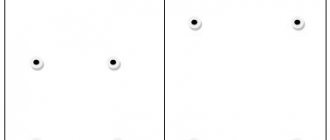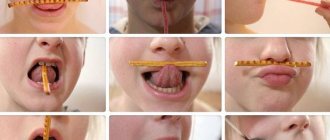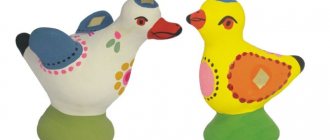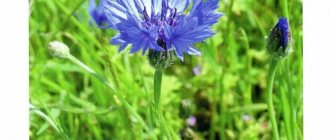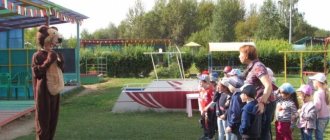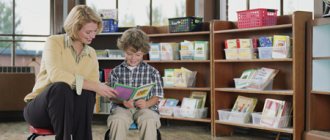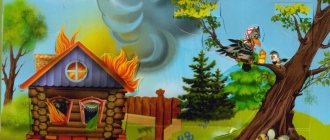Lesson 6. Dymkovo duck (Clay modeling)
Program content. Continue to introduce children to folk crafts, consolidate and deepen knowledge about the Dymkovo toy.
Involve in making clay toys of the Dymkovo type. Learn to see the expressiveness of a toy’s shape, sculpt a duck from life in a constructive way (from individual parts), observing shapes, proportions and details. Learn to place the figurine evenly and beautifully on the stand. Continue to teach how to mark feathers, wings and eyes in stacks; decorate the wings and head with moldings, balls, cakes. Material. Dymkovo clay toys (whistles: ducks, cockerels, deer, horses; ladies in kokoshniks and hats). Clay, bowls of water, rags, drinking glasses, modeling boards (for each child).
Progress of the lesson
Tell the children about the Dymkovo toy: “This toy originated in ancient times in the village of Dymkovo near the city of Kirov. In winter, the houses of craftsmen were full of clay, bags of chalk, boxes of paints, boxes of eggs, and jars of milk. That's pretty much all you need to make clay toys. The craftsmen knew how to turn a piece of clay into a duck or a rooster.”
Consider a duck whistle with your children. Explain how to attach a beautifully curved neck and a high-raised head to the body, and pinch the tail. Attach thick short legs-stands to the base body. Remind that the joints of all parts must be moistened with water and smoothed.
Invite the children to become Dymkovo craftsmen and sculpt such a duck.
When the toys are dry, they should be coated with water-based paint or white gouache mixed with a drop of PVA glue, and during a drawing lesson the ducks should be painted with Dymkovo patterns.
How to make a duck from plasticine
Modeling animals and birds is the most popular subject of creative activities, which is due to the wide choice for children's creativity. It is recommended to begin the development of creative skills by sculpting such simple figures as a duck. By gradually performing certain actions, the child will be able to make a bird both independently and with the help of an adult.
A simple duck version
The easiest way to sculpt a duck involves performing the following steps in the prescribed sequence:
- You need to prepare material in brown, burgundy, orange and green. Two large balls are rolled out of dark plasticine, a medium-sized ball from green, and a small ball from yellow.
- The brown ball is the body of the future duck. It is necessary to pull it to one side and press down a little, giving it stability.
- Burgundy material will be needed to make the neck and head. The parts must be connected to each other.
- From drop-shaped blanks made of burgundy and green colors, you need to fashion two wings.
- Using a stack, feathers are drawn on the wings. The wings are glued to the sides of the duck's body.
- Two indentations for the eyes are made on the head: two balls of white plasticine are inserted into the dimples on the head.
- An orange tint will be needed to make a flat beak and, bending it slightly, stick it in the center of the head.
- Once all of the above steps are completed, all that remains is to finish drawing the eyelashes and eyebrows.
Modeling a little duckling
The little duckling is a simplified version of the craft that even a child can handle. Yellow plasticine will be used as a base: the feathers of the chicks are exactly this color.
In order to make a little duckling, you will need to perform the following steps:
- Prepare yellow, white, black and red materials and form small balls.
- The body of the bird, the head, and the wings will be made from yellow plasticine. One piece is divided into three parts, the largest of which will become the body of the duckling, the middle one will become the wings, and the small one will become the head. When ready, the parts need to be connected to each other.
- You need to form a beak from red plasticine and stick it to the center of the head.
- All that remains is to make the eyes from black and white plasticine and attach them to the head.
Duck using natural materials
The use of natural materials is an excellent opportunity to realize the most daring creative ideas.
In order to make a duck from natural material, you will need to prepare:
- Cones
- Plasticine of different colors
- Grass and pebbles
- Blue cardboard
- Glue gun
- Paints and brush
A duck made from cones is a craft for which the child will need the help of an adult:
- From brown plasticine it is necessary to form the head and neck of the future duck.
- The green mass is the plumage of a bird. It is glued to the body blank.
- It is necessary to sculpt a beak from a material of a light brown or mustard shade and fix it in the center of the head.
- The duck's eyes will be made of black and orange material: you need to form two balls of each shade. The black balls should be smaller than the orange ones. Bright flattened blanks are attached to the sides of the head, and black balls are glued to them.
- Red plasticine is for paws. They form and attach to the bottom of the bud.
- You will need cardboard to create the base: you need to cut out an oval.
- Cardboard is an imitation of a lake: grass is placed on one side and pebbles on the other. For reliable fixation, you must use a glue gun. The finished duck can be seated in the middle of the lake: the craft is ready.
Lesson 7. Fly agaric (Applying plasticine to the surface)
Program content. Strengthen children's ability to use familiar methods of conveying an image: carefully apply plasticine in a thin layer inside the outline and decorate it using the molding method. Expand and clarify knowledge about mushrooms. Give an idea that mushrooms can be edible and poisonous. Develop creativity when designing your crafts.
Material. Cards with images of mushrooms: porcini mushroom, boletus, honey mushroom, russula, red fly agaric, toadstool. Cardboard with a drawn silhouette of a fly agaric, plasticine, stand boards (for each child).
Progress of the lesson
Show the children pictures of mushrooms and describe each mushroom with the children. Please draw their attention to the fact that there are mushrooms that should never be picked or eaten - fly agaric and toadstool. Carefully examine the fly agaric with your children, tell them: “This is a large mushroom with a red cap decorated with white spots. The red color indicates danger; the mushroom warns everyone that it is poisonous. Fly agarics have a white leg with a wavy ring under the cap.”
Invite the children to sculpt this dangerous mushroom to help them remember it better.
Explain the sequence of work: red plasticine is applied to the cardboard inside the outline and the cap is decorated with white dots. The leg is made of white plasticine. You can place green grass at the bottom.
The children begin to sculpt.
Summary of a modeling lesson in the middle group of the kindergarten "Duck"
Lesson in the middle group.
Modeling “Duck” Purpose: to teach children to sculpt an object consisting of several parts. Tasks: 1. Reinforce sculpting techniques: separate parts from a whole piece and maintain their size when sculpting, roll the dough between your palms, connect the parts, pressing them tightly against each other, practice using the technique of pinching and pulling; 2. Develop fine motor skills of the fingers. 3. Develop the ability to work in a team, causing a positive emotional response to the overall result. Materials and equipment : salt dough;
boards; napkins; for each child); lake is a mirror; duck mask hats for each child; toys - poultry; musical accompaniment; “Worms” marmalade to encourage children. Progress of the lesson.
Educator : Hello, guys! Children : Hello! (The voices of poultry are heard). Educator : I was just about to feed my poultry. Will you help me? Children : Yes Riddles Clucks, clucks, calls the children, gathers everyone under his wing. Children: Chicken Teacher: Well done, guess another riddle: Red paws, pinches your heels, Run without looking back! Children : goose! Educator: And you guessed this riddle! Well, now you can’t guess: She walks in the rain, She loves to cut grass! “Quack! "Shouts, It's all a joke, Well, of course it is... Children: Duck! Educator: Well done, guys, here's another riddle. Amazing child! Just out of diapers He can swim and dive, like his own mother. Children : Duckling! Educator: Well done! So you guessed it. This is a duck and ducklings. They are not in the yard, they probably went to the lake. Let's go look for them. The teacher and the children approach the table on which the lake is decorated. They surround him from all sides. One duck swims on the lake). Educator : Look, guys, the duck is swimming alone, you can see the kids are hiding in the grass. The mother duck felt lonely and began to call them. “Quack-quack-quack! ", but the ducklings do not respond. Mother duck asks you to help find her ducklings. Let's help her! How can we help her, guys? Children : ... you can make ducklings... Educator: of course, you can make ducklings! But first, let's play with you a little. The ducks came out into the meadow, (we walk like ducklings) - Quack-Quack-Quack! A cheerful beetle flew by - Zhzhzhzhzh! (we wave our arms - wings). Geese arch their necks - Ga-Ga-Ga (circular rotation of the neck). The feathers are straightened with the beak (the body turns left and right). The wind swayed the branches (we swing our arms raised up, Sharik also growled - Rrrrr (hands on the belt, bend forward, look in front of us). The reeds whispered in the water - Shhhhhhhhh (raise your arms up and stretch, And again there was silence - Shhhhhhhh... (crouched) Educator : Well done! Now sit down at the tables, we must help the mother duck. Educator: Look, children, what parts does a duck consist of? Children : Head, body. The head is smaller, the body is larger. The head is round, and the body is oval. Educator : What do you think, what is this? Children: Beak, tail. Educator: Well done! First you need to divide the dough into two parts. One piece of dough, which is larger, will be the body; a smaller piece will be the head. To sculpt the body of the duck, we need to take a piece of plasticine, which is larger, and roll it into an oval in your palms. Then we also sculpt the head, only with a ball. Next, we connect these two parts, pressing them tightly to each other. But very carefully so that the shape does not break. Then we, guys , by pinching, we make a beak on the head of the duckling and pull it back a little, and on the body, where the tail should be, we pull it out. Look how I do it. Our duckling is almost ready. Is he missing some eyes or something else? Children: Wings. Educator : Look, you have cereal (what kind of cereal) in your plate - buckwheat, make eyes out of it for the duckling. Carefully! Where the eyes should be, press the grain. (Music sounds, children start the lesson). Educator: Our duck in the pond is really looking forward to her ducklings! (Providing individual assistance to children) (Children finished work) . Educator: Now, guys, let’s go and put all the ducklings on the lake. Our duck is one, but there are many ducklings! Let's count them guys, see if they all returned to their mother! Children count: 1;2;3;4;5;6;7;8;9;10. You guys are great, you did a great job! Look how happy the mother duck is! And the ducklings are happy too, they have returned to their mother! Everyone has fun, and so do we! Educator: So that our guests also have a good mood, let's dance for them together with our duck and ducklings. Please, everyone, stand around the lake, and I will put on duckling hats and masks for you. Now listen to the music and repeat all the movements after me. (Music sounds. Children dance the dance of little ducklings) Educator : What a great fellow you are! Me and the duck thank you for the wonderful dance. And the duck also wants to thank you for returning the babies to her! She handed you the treat. Now let's not bother our duck and ducklings, let's go play.
We recommend watching:
Summary of educational activities for children with parents in the middle group. Do-it-yourself doll Summary of a lesson on speech development on the topic “Toys” in the middle group Methodological development of GCD for the development of communicative activities in children of the middle group Synopsis of a game lesson in mathematics in the middle group of a preschool educational institution
Similar articles:
Lesson in the middle group “Winter clothes”
Math lesson notes “Number 1”. Middle group
Lesson 8. Hedgehog (Modeling from plasticine in combination with natural materials)
Program content. Continue to teach children to combine natural materials and plasticine in crafts. Strengthen the ability to convey in sculpting the proportional relationship of parts and their location. Learn to achieve expressiveness of the image. Continue learning to connect the parts by pressing them. Develop your imagination when adding the necessary elements to the product (mushrooms, leaves, grass, etc.). Strengthen the ability to understand and analyze the content of a poem.
Material. Pine cones, plasticine, various natural materials (pine or spruce needles, small twigs, small dry tree leaves), cardboard stands, modeling boards (for each child).
What you need to sculpt a duck from plasticine
In order to make a duck, you will need a minimum amount of material and tools:
- Multi-colored plasticine
- Stack or knife
- Toothpick
- Substrate
Making crafts from plasticine is an excellent opportunity to develop a child’s artistic skills and imagination. Experts recommend starting creative activities from the age of three: it is at this age that the child absorbs information with interest.
Progress of the lesson
Read the poem by S. Marshak to the children:
There is a hedgehog living under our chair, a prickly, quiet hedgehog. It looks very much like a brush, When the legs are not visible.
Do you understand why a hedgehog has needles? So that the Boys or wolves do not touch him.
Ask the children: “Who is this poem about? (About a hedgehog.) What does a hedgehog look like? (Children’s answers.) Why do I eat needles?” (So that no one offends him.)
Invite them to look at a pine cone and think about how they can turn it into a hedgehog. Discuss with the guys the sequence of work: first sculpt a muzzle and attach it to the blunt edge of the cone, then make legs, eyes, a nose out of plasticine, cut the mouth with stacks. You can attach small apples, mushrooms, and needles to the back of the cone. Place the hedgehog on a cardboard coated with green plasticine, decorated with grass in the form of pine needles, fallen leaves, and tree branches.
Progress of the lesson
Read G. Sapgir’s tongue twister to the children:
The Seagull warmed up the teapot, invited the Nine Seagulls: - Come, everyone, for tea! - How many seagulls? Answer!
Ask the children: “Why did the seagull invite nine seagulls?” (Drink tea.) How many cups do you need for all the seagulls?” (Ten.)
Invite the children to make a beautiful cup for each seagull. From a piece of plasticine you need to separate a small part for the bottom of the cup with a stack. Roll it into a ball and flatten it into a disk. Divide the remaining plasticine into equal pieces, roll into sausages, and roll into rings. Attach the first ring to the bottom of the cup, then attach all the other rings on top of each other. Roll up another roll and attach it to the side of the cup in the form of a handle.
Progress of the lesson
Start your lesson with finger gymnastics.
Educator: “We twist our hands, twist them, twist them and make a table. (One hand in a fist, the palm of the other hand lies on the fist.)
We twist our arms, twist, twist, we get a chair. (One hand is clenched into a fist, the palm of the other hand is placed on the side of the fist in the form of a back.)
We twist, twist, twist our arms and pretend to be a bed. (The palms of the hands are pressed to each other by the sides.)
We twist, we twist, we twist, we make a sofa. (The sides of the palms are connected perpendicular to each other.)
We twist, we twist, we twist, we show the closet.” (The palms are connected by the sides in the form of cabinet doors and can move in different directions like sliding wardrobes or open outwards like regular cabinets.) And so on.
Invite the children to first fashion a table out of plasticine: roll up a ball, press it into a disk with your palms and trim the edges with a stack to make a quadrangle. Then roll up four rollers of equal length - table legs - and attach them to the table top. Moisten the joints with water.
The chair is made in the same way as the table, only smaller in size. A square made from a plasticine disk is attached to the side of the seat by cutting off the edges.
SUMMARY OF MODELING NODES TOPIC: “Duck with ducklings.”
SUMMARY OF STYLE NODES
TOPIC: "Duck with ducklings."
Target:
teach children to sculpt an object consisting of several parts, showing some characteristic features (elongated beak, tail).
Tasks:
Educational:
- Strengthen modeling techniques: rolling the dough between your palms;
- Practice using the technique of pinching and pulling;
Educational:
- Strengthen the ability to connect parts, pressing them tightly to each other, and smoothing the seams.
Educators:
- Foster a positive emotional response to the overall result.
Preliminary work:
Conversation with children about poultry (geese, ducks, chickens); looking at illustrations of ducklings, chickens, geese, goslings; game “How are they similar? What is the difference?" (comparison of chicks and ducklings); guessing riddles about birds.
Materials and equipment:
salted colored dough; boards; napkins; duck toys for each child); lake is a mirror; duck mask hats for each child; house layout; wattle fence; toys – pet birds; hostess costume for the teacher; musical accompaniment; a huge toy egg to encourage children and “Worms” marmalade.
GCD move
Introductory part:
(Children enter the group and are greeted by a teacher in Russian folk costume). Educator: Hello, guys! Children: Hello! (Music sounds from the voices of poultry and animals). Educator: Oh, what guests I have! I'm so glad to see you! Come in, dear guests! And I was just about to feed my poultry. Now you can guess which birds. She walks in the rain and loves to cut grass! "Quack!" screams, This is all a joke, Well, of course it is... Children: Duck! Educator: Well done, guys, here's another riddle. Amazing child! Just out of diapers He can swim and dive, like his own mother. Children: Duckling!
Educator: Well done! So you guessed it. This is a duck and ducklings. They are not in the yard, they probably went to the lake. Let's go look for them. (Children pass a strip with physical education equipment: a bridge; hummocks. The teacher and the children approach the table on which the lake is decorated. They surround it on all sides. One duck swims on the lake). Educator: Look, guys, the duck is swimming alone, you can see the kids are hiding in the grass. The mother duck felt lonely and began to call them. “Quack-quack-quack!”, but the ducklings don’t respond. Mother duck asks you to help find her ducklings. Let's help her! How can we help her, guys? Children (answer options): ... you can blind...
Educator: of course, you can make ducklings! But first, let's play with you a little. The ducks came out into the meadow, (we walk like ducklings) - Quack-Quack-Quack! A cheerful beetle flew by - Zhzhzhzhzh! (we wave our arms - wings). Geese arch their necks - Ga-Ga-Ga (circular rotation of the neck). The feathers are straightened with the beak (the body turns left and right). The wind swayed the branches (we swing our arms up), Sharik also growled - Rrrrr... (hands on the belt, bending forward, looking in front of us). The reeds whispered in the water - Shhhhhhhh... (raise your arms up and stretch), And again there was silence - Shhhhhhh... (crouched down).
Main part:
Educator: Well done! Now sit down at the tables, we must help the mother duck.
Educator: Look, children, what parts does a duck consist of?
Children: Head, torso. The head is smaller, the body is larger. Educator: What shape is a duck’s body? Elongated, oval
Educator: Correct. What shape is the duck's head? Also oval.
Educator: What do you think, what is this? Children: Beak, tail.
Educator: Well done! First you need to divide the plasticine into two parts. One piece of plasticine, which is larger, will be the body; a smaller piece is the head. To sculpt the body of a duck, we need to take a larger piece of plasticine and roll it into an oval with our palms. Then we also sculpt the head, only with a ball. Next, we connect these two parts, pressing them tightly against each other. But be very careful so that the shape does not break. Then we guys, by plucking, make a beak on the duckling’s head and pull it back a little, and on the body, where the tail should be, we pull it out. Look how I do it.
Our duckling is almost ready. Is he missing some eyes or something else?
Children: Wings!..
Educator: look, you have buckwheat in your plate, make eyes out of it for the duckling. Carefully! Where the eyes should be, press the grain. If everything is clear, start the lesson. (Music sounds, children start the lesson). Educator: Our duck in the pond is really looking forward to her ducklings! (The children finished their work).
Educator: Now, guys, let’s go and put all the ducklings on the lake. There is a fish in the pond, and ducklings love to eat
This fish in the mornings, in the mornings and evenings. And of course at lunch too! The fish will help them grow!
Our duck is one, but there are many ducklings! Let's count them guys!
Final part:
Educator: Well done, you did a great job today! Look how happy the mother duck is! And the ducklings are happy too, they have returned to their mother! Everyone has fun, and so do we! After all, we did a good deed. Is it true? Children: Yes!!
